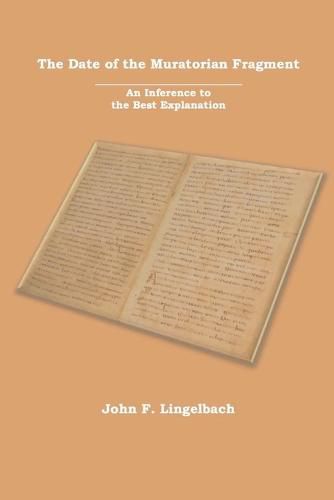Readings Newsletter
Become a Readings Member to make your shopping experience even easier.
Sign in or sign up for free!
You’re not far away from qualifying for FREE standard shipping within Australia
You’ve qualified for FREE standard shipping within Australia
The cart is loading…






This title is printed to order. This book may have been self-published. If so, we cannot guarantee the quality of the content. In the main most books will have gone through the editing process however some may not. We therefore suggest that you be aware of this before ordering this book. If in doubt check either the author or publisher’s details as we are unable to accept any returns unless they are faulty. Please contact us if you have any questions.
Three hundred years after its discovery, scholars find themselves unable to determine the more likely of the two hypotheses regarding the date of the Muratorian Fragment, which consists of a catalog of New Testament texts. Is the Fragment a late second- to early third-century composition or a fourth-century composition? This present work seeks to break the impasse. The study found that, by making an inference to the best explanation, a second-century date for the Fragment is preferred. This methodology consists of weighing the two hypotheses against five criteria: plausibility, explanatory scope, explanatory power, credibility, and simplicity. What makes this current work unique in its contribution to church history and historical theology is that it marks the first time the rigorous application of an objective methodology, known as inference to the best explanation (or IBE), has been formally applied to the problem of the Fragment’s date.
$9.00 standard shipping within Australia
FREE standard shipping within Australia for orders over $100.00
Express & International shipping calculated at checkout
This title is printed to order. This book may have been self-published. If so, we cannot guarantee the quality of the content. In the main most books will have gone through the editing process however some may not. We therefore suggest that you be aware of this before ordering this book. If in doubt check either the author or publisher’s details as we are unable to accept any returns unless they are faulty. Please contact us if you have any questions.
Three hundred years after its discovery, scholars find themselves unable to determine the more likely of the two hypotheses regarding the date of the Muratorian Fragment, which consists of a catalog of New Testament texts. Is the Fragment a late second- to early third-century composition or a fourth-century composition? This present work seeks to break the impasse. The study found that, by making an inference to the best explanation, a second-century date for the Fragment is preferred. This methodology consists of weighing the two hypotheses against five criteria: plausibility, explanatory scope, explanatory power, credibility, and simplicity. What makes this current work unique in its contribution to church history and historical theology is that it marks the first time the rigorous application of an objective methodology, known as inference to the best explanation (or IBE), has been formally applied to the problem of the Fragment’s date.